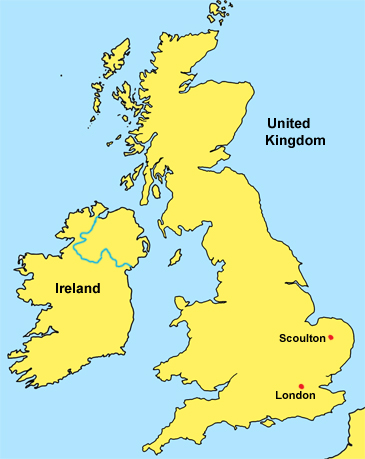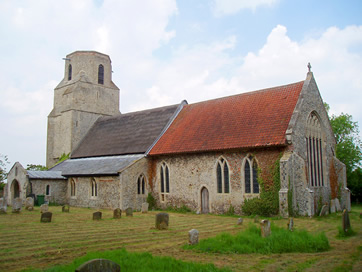 Chris Korte's New Zealand Genealogy Project
Chris Korte's New Zealand Genealogy Project
Scoulton, Norfolk, England
About page
This page has information about Scoulton in Norfolk where Ernest Edwin Rushbrooke (1859-1940) was born and spent his early life. He grew up on Abergavenny Farm, Clipbush Lane, Scoulton.
If you can provide additional information, or corrections, please contact (see Info menu).
Scoulton
The location of Scoulton parish and village is shown on the map below. The village is in the east of England in Norfolk, situated 16 miles (26 km) west of the city of Norwich. Traditionally agricultural, the village is increasingly a dormitory for workers in Norwich. In 2001 Scoulton parish (9.02 square kilometers) had a population of 241 in 94 households, and 246 people in 2011.

A village school was built in 1841 but was forced to close in 1985 because of falling numbers. The methodist church, built in 1909; it is now a private house. The only pub in the village closed in 1957.
The Church of the Holy Trinity in Scoulton dates mostly to the 14th century and stands at the meeting of the three manors. Inside are reminders of some of the most significant landowners. In the north window of the chancel are the arms of William de Mortimer. There also hangs a hatchment of the Wayland Arms and a marble wall tablet records members of the Daye (or d'Eye) family. Some members of the Rushbrooke family are buried in the churchyard.
19th Century Scoulton
The following is the Scoulton entry in Kelly's Directory for Cambridgeshire, Norfolk & Suffolk, 1883, p.487.
Scoulton is a parish and village 6 miles north-west from Attleborough and 4 east from Watton station, in the Western division of the county, hundred and union of Wayland, rural deanery of Breckles and archdeaconry and diocese of Norwich. The church of Holy Trinity is an ancient flint building, in the Early English style, consisting of chancel, nave, aisles, and porch, with tower surmounted by an octagonal belfry containing three bells. The register dates from the year 1550, but is very imperfect. The living is a discharged rectory, yearly value £550, including 53 acres of glebe, with residence in the gift of John Weyland esq. and held by the Rev. Henry Robert Arthur Johnson M.A. of Magdalene College, Cambridge, appointed in 1883. The fuel allotment of 39 acres is let for £40 yearly. Here is a fine sheet of water 1 miles in circumference, enclosing a swampy island, the property of John Weyland esq. remarkable for the breeding-place of innumerable gulls, of the beautiful species, Laru ridibundus (the black-headed, or laughing gull), which congregate in March and retire in August: their eggs are considered very delicious. The principal landowners are John Weyland esq. who is lord of the manor, Henry Hemsworth and Edward M. Dewing esq. The soil is mixed; subsoil, clay. The chief crops are wheat and barley. The parish contains 2,193 acres; rateable value £3,142; and in 1881 the population was 326.
POST OFFICE.— Henry Robert Tyrrell, receiver. Letters through Thetford arrive at 9.20 a.m. dispatched at 8.20 p.m. The nearest money order & telegraph office is at Hingham.
SCHOOL.— John K. Pelly, master; Mrs. Frances Pelly, mistress
CHURCH.— Johnson Rev, Henry Robert Arthur, M.A. Rectory
COMMERCIAL.
Brasnett Thomas Rowling, farmer, Weyland farm
Clarke Abna, shoe maker
Cocklng Thomas, shoe maker
Durrant Charles, Abergavenny farm
Harvey George, farmer
Lebbell Isaac, blacksmith
Norton John, farmer, Hall farm
Nurse William, Day's arms
Rushbrooke Alban, jun. farmer
Tingey John Thomas, farmer
Tyrrell Henry Robert, shopkeeper & farmer
Note - Alban Rushbrooke (senior) had lost the lease of Abergavenny farm after being declared bankrupt in 1881. Rushbrooke Alban, junior had leased Messop Farm in 1881.
 |  |
| Holy Trinity Church, Scoulton | Holy Trinity Church, Scoulton |
Page last updated on 28 July 2018.







